Deep Learning & Art: Neural Style Transfer
Welcome to the second assignment of this week. In this assignment, you will learn about Neural Style Transfer. This algorithm was created by Gatys et al. (2015) (https://arxiv.org/abs/1508.06576).
In this assignment, you will:
- Implement the neural style transfer algorithm
- Generate novel artistic images using your algorithm
Most of the algorithms you've studied optimize a cost function to get a set of parameter values. In Neural Style Transfer, you'll optimize a cost function to get pixel values!
【中文翻译】
- 实现神经风格转换算法
- 使用您的算法生成新的艺术图像
【code】
import os import sys import scipy.io import scipy.misc import matplotlib.pyplot as plt from matplotlib.pyplot import imshow from PIL import Image from nst_utils import * import numpy as np import tensorflow as tf %matplotlib inline
1 - Problem Statement
Neural Style Transfer (NST) is one of the most fun techniques in deep learning. As seen below, it merges two images, namely, a "content" image (C) and a "style" image (S), to create a "generated" image (G). The generated image G combines the "content" of the image C with the "style" of image S.
In this example, you are going to generate an image of the Louvre museum in Paris (content image C), mixed with a painting by Claude Monet, a leader of the impressionist movement (style image S).

Let's see how you can do this.
【中文翻译】
图片见英文部分
让我们看看你怎么能做到这一点。
2 - Transfer Learning
Neural Style Transfer (NST) uses a previously trained convolutional network, and builds on top of that. The idea of using a network trained on a different task and applying it to a new task is called transfer learning.
Following the original NST paper (https://arxiv.org/abs/1508.06576), we will use the VGG network. Specifically, we'll use VGG-19, a 19-layer version of the VGG network. This model has already been trained on the very large ImageNet database, and thus has learned to recognize a variety of low level features (at the earlier layers) and high level features (at the deeper layers).
Run the following code to load parameters from the VGG model. This may take a few seconds.
【code】
model = load_vgg_model("pretrained-model/imagenet-vgg-verydeep-19.mat")
print(model)
【result】
{'input': <tf.Variable 'Variable:0' shape=(1, 300, 400, 3) dtype=float32_ref>,
'conv1_1': <tf.Tensor 'Relu:0' shape=(1, 300, 400, 64) dtype=float32>,
'conv1_2': <tf.Tensor 'Relu_1:0' shape=(1, 300, 400, 64) dtype=float32>,
'avgpool1': <tf.Tensor 'AvgPool:0' shape=(1, 150, 200, 64) dtype=float32>,
'conv2_1': <tf.Tensor 'Relu_2:0' shape=(1, 150, 200, 128) dtype=float32>,
'conv2_2': <tf.Tensor 'Relu_3:0' shape=(1, 150, 200, 128) dtype=float32>,
'avgpool2': <tf.Tensor 'AvgPool_1:0' shape=(1, 75, 100, 128) dtype=float32>,
'conv3_1': <tf.Tensor 'Relu_4:0' shape=(1, 75, 100, 256) dtype=float32>,
'conv3_2': <tf.Tensor 'Relu_5:0' shape=(1, 75, 100, 256) dtype=float32>,
'conv3_3': <tf.Tensor 'Relu_6:0' shape=(1, 75, 100, 256) dtype=float32>,
'conv3_4': <tf.Tensor 'Relu_7:0' shape=(1, 75, 100, 256) dtype=float32>,
'avgpool3': <tf.Tensor 'AvgPool_2:0' shape=(1, 38, 50, 256) dtype=float32>,
'conv4_1': <tf.Tensor 'Relu_8:0' shape=(1, 38, 50, 512) dtype=float32>,
'conv4_2': <tf.Tensor 'Relu_9:0' shape=(1, 38, 50, 512) dtype=float32>,
'conv4_3': <tf.Tensor 'Relu_10:0' shape=(1, 38, 50, 512) dtype=float32>,
'conv4_4': <tf.Tensor 'Relu_11:0' shape=(1, 38, 50, 512) dtype=float32>,
'avgpool4': <tf.Tensor 'AvgPool_3:0' shape=(1, 19, 25, 512) dtype=float32>,
'conv5_1': <tf.Tensor 'Relu_12:0' shape=(1, 19, 25, 512) dtype=float32>,
'conv5_2': <tf.Tensor 'Relu_13:0' shape=(1, 19, 25, 512) dtype=float32>,
'conv5_3': <tf.Tensor 'Relu_14:0' shape=(1, 19, 25, 512) dtype=float32>,
'conv5_4': <tf.Tensor 'Relu_15:0' shape=(1, 19, 25, 512) dtype=float32>,
'avgpool5': <tf.Tensor 'AvgPool_4:0' shape=(1, 10, 13, 512) dtype=float32>}
The model is stored in a python dictionary where each variable name is the key and the corresponding value is a tensor containing that variable's value. To run an image through this network, you just have to feed the image to the model. In TensorFlow, you can do so using the tf.assign function. In particular, you will use the assign function like this:
【code】
model["input"].assign(image)
This assigns the image as an input to the model. After this, if you want to access the activations of a particular layer, say layer 4_2 when the network is run on this image, you would run a TensorFlow session on the correct tensor conv4_2, as follows:
【code】
sess.run(model["conv4_2"])
【中文翻译】
【code】
model = load_vgg_model("pretrained-model/imagenet-vgg-verydeep-19.mat")
print(model)
【result】
{'input': <tf.Variable 'Variable:0' shape=(1, 300, 400, 3) dtype=float32_ref>,
'conv1_1': <tf.Tensor 'Relu:0' shape=(1, 300, 400, 64) dtype=float32>,
'conv1_2': <tf.Tensor 'Relu_1:0' shape=(1, 300, 400, 64) dtype=float32>,
'avgpool1': <tf.Tensor 'AvgPool:0' shape=(1, 150, 200, 64) dtype=float32>,
'conv2_1': <tf.Tensor 'Relu_2:0' shape=(1, 150, 200, 128) dtype=float32>,
'conv2_2': <tf.Tensor 'Relu_3:0' shape=(1, 150, 200, 128) dtype=float32>,
'avgpool2': <tf.Tensor 'AvgPool_1:0' shape=(1, 75, 100, 128) dtype=float32>,
'conv3_1': <tf.Tensor 'Relu_4:0' shape=(1, 75, 100, 256) dtype=float32>,
'conv3_2': <tf.Tensor 'Relu_5:0' shape=(1, 75, 100, 256) dtype=float32>,
'conv3_3': <tf.Tensor 'Relu_6:0' shape=(1, 75, 100, 256) dtype=float32>,
'conv3_4': <tf.Tensor 'Relu_7:0' shape=(1, 75, 100, 256) dtype=float32>,
'avgpool3': <tf.Tensor 'AvgPool_2:0' shape=(1, 38, 50, 256) dtype=float32>,
'conv4_1': <tf.Tensor 'Relu_8:0' shape=(1, 38, 50, 512) dtype=float32>,
'conv4_2': <tf.Tensor 'Relu_9:0' shape=(1, 38, 50, 512) dtype=float32>,
'conv4_3': <tf.Tensor 'Relu_10:0' shape=(1, 38, 50, 512) dtype=float32>,
'conv4_4': <tf.Tensor 'Relu_11:0' shape=(1, 38, 50, 512) dtype=float32>,
'avgpool4': <tf.Tensor 'AvgPool_3:0' shape=(1, 19, 25, 512) dtype=float32>,
'conv5_1': <tf.Tensor 'Relu_12:0' shape=(1, 19, 25, 512) dtype=float32>,
'conv5_2': <tf.Tensor 'Relu_13:0' shape=(1, 19, 25, 512) dtype=float32>,
'conv5_3': <tf.Tensor 'Relu_14:0' shape=(1, 19, 25, 512) dtype=float32>,
'conv5_4': <tf.Tensor 'Relu_15:0' shape=(1, 19, 25, 512) dtype=float32>,
'avgpool5': <tf.Tensor 'AvgPool_4:0' shape=(1, 10, 13, 512) dtype=float32>}
模型存储在 python 字典中, 其中每个变量名都是key, 对应的值是包含该变量值的tensor。若要通过此网络运行图像, 只需将图像提供给模型。在 TensorFlow 中, 您可以使用 tf.assign函数。特别地, 您将使用如下所指的赋值函数:
【code】
model["input"].assign(image)
这会将图像分配给模型的输入。在此之后, 如果要访问特定层的激活值, 请在该图像上运行网络时说 "layer 4_2", 则在正确的tensor conv4_2 上运行 TensorFlow session, 如下所示:
【code】
sess.run(model["conv4_2"])
3 - Neural Style Transfer
We will build the NST algorithm in three steps:
- Build the content cost function Jcontent(C,G)
- Build the style cost function Jstyle(S,G)
- Put it together to get J(G)=αJcontent(C,G)+βJstyle(S,G).
3.1 - Computing the content cost
In our running example, the content image C will be the picture of the Louvre Museum in Paris. Run the code below to see a picture of the Louvre.
【code】
content_image = scipy.misc.imread("images/louvre.jpg")
imshow(content_image)
【result】
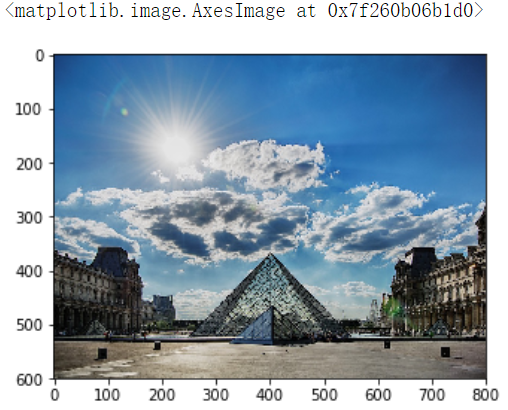
The content image (C) shows the Louvre museum's pyramid surrounded by old Paris buildings, against a sunny sky with a few clouds.
3.1.1 - How do you ensure the generated image G matches the content of the image C?
As we saw in lecture, the earlier (shallower) layers of a ConvNet tend to detect lower-level features such as edges and simple textures, and the later (deeper) layers tend to detect higher-level features such as more complex textures as well as object classes.
We would like the "generated" image G to have similar content as the input image C. Suppose you have chosen some layer's activations to represent the content of an image. In practice, you'll get the most visually pleasing results if you choose a layer in the middle of the network--neither too shallow nor too deep. (After you have finished this exercise, feel free to come back and experiment with using different layers, to see how the results vary.)
So, suppose you have picked one particular hidden layer to use. Now, set the image C as the input to the pretrained VGG network, and run forward propagation. Let a(C) be the hidden layer activations in the layer you had chosen. (In lecture, we had written this as a[l](C), but here we'll drop the superscript [l] to simplify the notation.) This will be a nH×nW×nC tensor. Repeat this process with the image G: Set G as the input, and run forward progation. Let a(G) be the corresponding hidden layer activation. We will define as the content cost function as:

Here, nH,nW and nC are the height, width and number of channels of the hidden layer you have chosen, and appear in a normalization term in the cost. For clarity, note that a(C) and a(G) are the volumes corresponding to a hidden layer's activations. In order to compute the cost Jcontent(C,G), it might also be convenient to unroll these 3D volumes into a 2D matrix, as shown below. (Technically this unrolling step isn't needed to compute Jcontent ,but it will be good practice for when you do need to carry out a similar operation later for computing the style const Jstyle.)


这里, nH、nW 和 nC 是您选择的隐藏层的高度、宽度和通道数, 并在成本中显示为标准化的值。为清楚起见, 请注意, a (C) 和 a (G) 是与隐藏层的激活值相对应的volume。为了计算成本 Jcontent (C, G), 也可以方便地将这些3D volume展开为2D matrix, 如下所示。(技术上这展开步骤不需要计算 Jcontent, 但在以后需要执行类似的操作以计算样式常量 Jstyle 时, 这将是一个很好的实践。 )

Exercise: Compute the "content cost" using TensorFlow.
Instructions: The 3 steps to implement this function are:
- Retrieve dimensions from a_G:
- To retrieve dimensions from a tensor X, use:
X.get_shape().as_list()
- To retrieve dimensions from a tensor X, use:
- Unroll a_C and a_G as explained in the picture above
- Compute the content cost:
【code】
# GRADED FUNCTION: compute_content_cost
def compute_content_cost(a_C, a_G):
"""
Computes the content cost
Arguments:
a_C -- tensor of dimension (1, n_H, n_W, n_C), hidden layer activations representing content of the image C
a_G -- tensor of dimension (1, n_H, n_W, n_C), hidden layer activations representing content of the image G
Returns:
J_content -- scalar that you compute using equation 1 above.
"""
### START CODE HERE ###
# Retrieve dimensions from a_G (≈1 line)
m, n_H, n_W, n_C = a_G.get_shape().as_list()
# Reshape a_C and a_G (≈2 lines)
a_C_unrolled = tf.reshape(tf.transpose(a_C, perm=[3, 1, 2, 0]), [n_C, n_H*n_W, -1]) # tanspose后a_C的维度(n_C,n_H, n_W,1)
a_G_unrolled = tf.reshape(tf.transpose(a_G, perm=[3, 1, 2, 0]), [n_C, n_H*n_W, -1]) # tanspose后a_G的维度(n_C,n_H, n_W,1)
# compute the cost with tensorflow (≈1 line)
J_content = tf.reduce_sum(tf.square(tf.subtract(a_C_unrolled, a_G_unrolled))) / (4 * n_H * n_W * n_C)
### END CODE HERE ###
return J_content
tf.reset_default_graph()
with tf.Session() as test:
tf.set_random_seed(1)
a_C = tf.random_normal([1, 4, 4, 3], mean=1, stddev=4)
a_G = tf.random_normal([1, 4, 4, 3], mean=1, stddev=4)
J_content = compute_content_cost(a_C, a_G)
print("J_content = " + str(J_content.eval()))
【result】
J_content = 6.76559
Expected Output:
| J_content | 6.76559 |
What you should remember:
- The content cost takes a hidden layer activation of the neural network, and measures how different a(C)a(C) and a(G)a(G) are.
- When we minimize the content cost later, this will help make sure GG has similar content as CC.
3.2 - Computing the style cost
For our running example, we will use the following style image:
【code】
style_image = scipy.misc.imread("images/monet_800600.jpg")
imshow(style_image)
【result】

This painting was painted in the style of impressionism(印象派).
Lets see how you can now define a "style" const function Jstyle(S,G)Jstyle(S,G).
3.2.1 - Style matrix
The style matrix is also called a "Gram matrix." In linear algebra, the Gram matrix G of a set of vectors (v1,…,vn) is the matrix of dot products, whose entries are Gij=viTvj=np.dot(vi,vj). In other words, Gij compares how similar vi is to vj : If they are highly similar, you would expect them to have a large dot product, and thus for Gij to be large.
Note that there is an unfortunate collision in the variable names used here. We are following common terminology used in the literature, but G is used to denote the Style matrix (or Gram matrix) as well as to denote the generated image G. We will try to make sure which G we are referring to is always clear from the context.
In NST, you can compute the Style matrix by multiplying the "unrolled" filter matrix with their transpose:

The result is a matrix of dimension (nC,nC)where nC is the number of filters. The value Gij measures how similar the activations of filter i are to the activations of filter j.
One important part of the gram matrix is that the diagonal elements such as Gii also measures how active filter i is. For example, suppose filter i is detecting vertical textures in the image. Then Gii measures how common vertical textures are in the image as a whole: If Gii is large, this means that the image has a lot of vertical texture.
By capturing the prevalence of different types of features (Gii), as well as how much different features occur together (Gij), the Style matrix G measures the style of an image.
【中文翻译】

Gram矩阵的一个重要部分是, 诸如 Gii 等对角线元素也测量了过滤器的激活程度。例如, 假设过滤器 i 正在检测图像中的垂直纹理。然后,Gii 测量了整个图像中的垂直纹理: 如果Gii 很大, 这意味着图像有很多垂直纹理。
# GRADED FUNCTION: gram_matrix
def gram_matrix(A):
"""
Argument:
A -- matrix of shape (n_C, n_H*n_W)
Returns:
GA -- Gram matrix of A, of shape (n_C, n_C)
"""
### START CODE HERE ### (≈1 line)
GA = tf.matmul(A,tf.transpose(A))
### END CODE HERE ###
return GA
tf.reset_default_graph()
with tf.Session() as test:
tf.set_random_seed(1)
A = tf.random_normal([3, 2*1], mean=1, stddev=4)
GA = gram_matrix(A)
print("GA = " + str(GA.eval()))
【result】
GA = [[ 6.42230511 -4.42912197 -2.09668207] [ -4.42912197 19.46583748 19.56387138] [ -2.09668207 19.56387138 20.6864624 ]]
Expected Output:
| GA | [[ 6.42230511 -4.42912197 -2.09668207] [ -4.42912197 19.46583748 19.56387138] [ -2.09668207 19.56387138 20.6864624 ]] |
3.2.2 - Style cost
After generating the Style matrix (Gram matrix), your goal will be to minimize the distance between the Gram matrix of the "style" image S and that of the "generated" image G. For now, we are using only a single hidden layer a[l], and the corresponding style cost for this layer is defined as:
![]()
where G(S) and G(G) are respectively the Gram matrices of the "style" image and the "generated" image, computed using the hidden layer activations for a particular hidden layer in the network.
Exercise: Compute the style cost for a single layer.
Instructions: The 3 steps to implement this function are:
- Retrieve dimensions from the hidden layer activations a_G:
- To retrieve dimensions from a tensor X, use:
X.get_shape().as_list()
- To retrieve dimensions from a tensor X, use:
- Unroll the hidden layer activations a_S and a_G into 2D matrices, as explained in the picture above.
- Compute the Style matrix of the images S and G. (Use the function you had previously written.)
- Compute the Style cost:
【code】
# GRADED FUNCTION: compute_layer_style_cost
def compute_layer_style_cost(a_S, a_G):
"""
Arguments:
a_S -- tensor of dimension (1, n_H, n_W, n_C), hidden layer activations representing style of the image S
a_G -- tensor of dimension (1, n_H, n_W, n_C), hidden layer activations representing style of the image G
Returns:
J_style_layer -- tensor representing a scalar value, style cost defined above by equation (2)
"""
### START CODE HERE ###
# Retrieve dimensions from a_G (≈1 line)
m, n_H, n_W, n_C =a_G.get_shape().as_list()
# Reshape the images to have them of shape (n_C, n_H*n_W) (≈2 lines)
a_S = tf.reshape(tf.transpose(a_S, perm=[3, 1, 2, 0]), [n_C, n_W*n_H])
a_G = tf.reshape(tf.transpose(a_G, perm=[3, 1, 2, 0]), [n_C, n_W*n_H])
# Computing gram_matrices for both images S and G (≈2 lines)
GS = gram_matrix(a_S)
GG = gram_matrix(a_G)
# Computing the loss (≈1 line)
J_style_layer = tf.reduce_sum(tf.square(tf.subtract(GS, GG))) / (4 * n_C**2 * (n_W * n_H)**2)
### END CODE HERE ###
return J_style_layer
tf.reset_default_graph()
with tf.Session() as test:
tf.set_random_seed(1)
a_S = tf.random_normal([1, 4, 4, 3], mean=1, stddev=4)
a_G = tf.random_normal([1, 4, 4, 3], mean=1, stddev=4)
J_style_layer = compute_layer_style_cost(a_S, a_G)
print("J_style_layer = " + str(J_style_layer.eval()))
【result】
J_style_layer = 9.19028
Expected Output:
| J_style_layer | 9.19028 |
3.2.3 Style Weights
So far you have captured the style from only one layer. We'll get better results if we "merge" style costs from several different layers. After completing this exercise, feel free to come back and experiment with different weights to see how it changes the generated image GG. But for now, this is a pretty reasonable default:
STYLE_LAYERS = [
('conv1_1', 0.2),
('conv2_1', 0.2),
('conv3_1', 0.2),
('conv4_1', 0.2),
('conv5_1', 0.2)]
You can combine the style costs for different layers as follows:
where the values for λ[l] are given in STYLE_LAYERS.
We've implemented a compute_style_cost(...) function. It simply calls your compute_layer_style_cost(...) several times, and weights their results using the values in STYLE_LAYERS. Read over it to make sure you understand what it's doing.
【code】
def compute_style_cost(model, STYLE_LAYERS):
"""
Computes the overall style cost from several chosen layers
Arguments:
model -- our tensorflow model
STYLE_LAYERS -- A python list containing:
- the names of the layers we would like to extract style from
- a coefficient for each of them
Returns:
J_style -- tensor representing a scalar value, style cost defined above by equation (2)
"""
# initialize the overall style cost
J_style = 0
for layer_name, coeff in STYLE_LAYERS:
# Select the output tensor of the currently selected layer
out = model[layer_name]
# Set a_S to be the hidden layer activation from the layer we have selected, by running the session on out
a_S = sess.run(out)
# Set a_G to be the hidden layer activation from same layer. Here, a_G references model[layer_name]
# and isn't evaluated yet. Later in the code, we'll assign the image G as the model input, so that
# when we run the session, this will be the activations drawn from the appropriate layer, with G as input.
a_G = out
# Compute style_cost for the current layer
J_style_layer = compute_layer_style_cost(a_S, a_G)
# Add coeff * J_style_layer of this layer to overall style cost
J_style += coeff * J_style_layer
return J_style
Note: In the inner-loop of the for-loop above, a_G is a tensor and hasn't been evaluated yet. It will be evaluated and updated at each iteration when we run the TensorFlow graph in model_nn() below.
What you should remember:
- The style of an image can be represented using the Gram matrix of a hidden layer's activations. However, we get even better results combining this representation from multiple different layers. This is in contrast to the content representation, where usually using just a single hidden layer is sufficient.
- Minimizing the style cost will cause the image G to follow the style of the image S.
3.3 - Defining the total cost to optimize
Finally, let's create a cost function that minimizes both the style and the content cost. The formula is:
![]()
Exercise: Implement the total cost function which includes both the content cost and the style cost.
【code】
# GRADED FUNCTION: total_cost
def total_cost(J_content, J_style, alpha = 10, beta = 40):
"""
Computes the total cost function
Arguments:
J_content -- content cost coded above
J_style -- style cost coded above
alpha -- hyperparameter weighting the importance of the content cost
beta -- hyperparameter weighting the importance of the style cost
Returns:
J -- total cost as defined by the formula above.
"""
### START CODE HERE ### (≈1 line)
J = alpha*J_content + beta*J_style
### END CODE HERE ###
return J
tf.reset_default_graph()
with tf.Session() as test:
np.random.seed(3)
J_content = np.random.randn()
J_style = np.random.randn()
J = total_cost(J_content, J_style)
print("J = " + str(J))
【result】
J = 35.34667875478276
Expected Output:
| J | 35.34667875478276 |
What you should remember:
- The total cost is a linear combination of the content cost Jcontent(C,G)J and the style cost Jstyle(S,G)
- α and β are hyperparameters that control the relative weighting between content and style
4 - Solving the optimization problem
Finally, let's put everything together to implement Neural Style Transfer!
Here's what the program will have to do:
- Create an Interactive Session
- Load the content image
- Load the style image
- Randomly initialize the image to be generated
- Load the VGG19 model
- Build the TensorFlow graph:
- Run the content image through the VGG19 model and compute the content cost
- Run the style image through the VGG19 model and compute the style cost
- Compute the total cost
- Define the optimizer and the learning rate
- Initialize the TensorFlow graph and run it for a large number of iterations, updating the generated image at every step.
Lets go through the individual steps in detail.
You've previously implemented the overall cost J(G). We'll now set up TensorFlow to optimize this with respect to G. To do so, your program has to reset the graph and use an "Interactive Session". Unlike a regular session, the "Interactive Session" installs itself as the default session to build a graph. This allows you to run variables without constantly needing to refer to the session object, which simplifies the code.
【中文翻译】
- 创建交互式会话
- 加载内容图像
- 加载样式图像
- 随机初始化要生成的图像
- 加载 VGG19 模型
- 生成 TensorFlow 图:
- 通过 VGG19 模型运行内容映像并计算内容成本
- 通过 VGG19 模型运行样式图像并计算样式成本
- 计算总成本
- 定义优化器和学习率
- 初始化 TensorFlow 图并为大量的迭代运行它, 并在每个步骤中更新生成的图像。
您以前实现了总成本 j (G) 。现在, 我们将建立 TensorFlow, 以优化该成本函数。为此, 您的程序必须重置图并使用 "交互式会话"。与常规会话不同, "交互式会话" 将自身安装为用于生成图的默认会话。这允许在不必经常需要引用会话对象的情况下,运行变量, 从而简化了代码。
Lets start the interactive session.
# Reset the graph tf.reset_default_graph() # Start interactive session sess = tf.InteractiveSession()
Let's load, reshape, and normalize our "content" image (the Louvre museum picture):
【code】content_image = scipy.misc.imread("images/louvre_small.jpg")
content_image = reshape_and_normalize_image(content_image)
Let's load, reshape and normalize our "style" image (Claude Monet's painting):
【code】
style_image = scipy.misc.imread("images/monet.jpg")
style_image = reshape_and_normalize_image(style_image)
Now, we initialize the "generated" image as a noisy image created from the content_image. By initializing the pixels of the generated image to be mostly noise but still slightly correlated with the content image, this will help the content of the "generated" image more rapidly match the content of the "content" image. (Feel free to look in nst_utils.py to see the details of generate_noise_image(...); to do so, click "File-->Open..." at the upper-left corner of this Jupyter notebook.)
【code】
generated_image = generate_noise_image(content_image) imshow(generated_image[0])
【result】
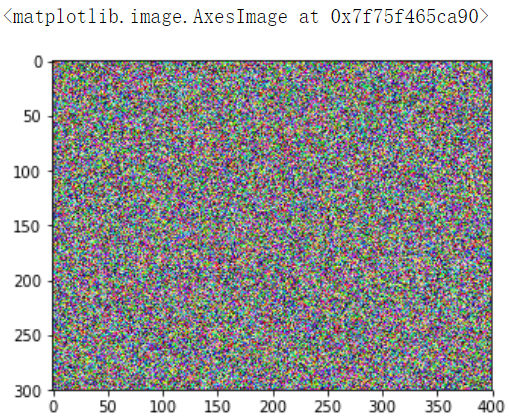
Next, as explained in part (2), let's load the VGG16 model.
【code】
model = load_vgg_model("pretrained-model/imagenet-vgg-verydeep-19.mat")
To get the program to compute the content cost, we will now assign a_C and a_G to be the appropriate hidden layer activations. We will use layer conv4_2 to compute the content cost. The code below does the following:
- Assign the content image to be the input to the VGG model.
- Set a_C to be the tensor giving the hidden layer activation for layer "conv4_2".
- Set a_G to be the tensor giving the hidden layer activation for the same layer.
- Compute the content cost using a_C and a_G.
【code】
# Assign the content image to be the input of the VGG model. sess.run(model['input'].assign(content_image)) # Select the output tensor of layer conv4_2 out = model['conv4_2'] # Set a_C to be the hidden layer activation from the layer we have selected a_C = sess.run(out) # Set a_G to be the hidden layer activation from same layer. Here, a_G references model['conv4_2'] # and isn't evaluated yet. Later in the code, we'll assign the image G as the model input, so that # when we run the session, this will be the activations drawn from the appropriate layer, with G as input. a_G = out # Compute the content cost J_content = compute_content_cost(a_C, a_G)
Note: At this point, a_G is a tensor and hasn't been evaluated. It will be evaluated and updated at each iteration when we run the Tensorflow graph in model_nn() below.
【code】
# Assign the input of the model to be the "style" image sess.run(model['input'].assign(style_image)) # Compute the style cost J_style = compute_style_cost(model, STYLE_LAYERS)
Exercise: Now that you have J_content and J_style, compute the total cost J by calling total_cost(). Use alpha = 10 and beta = 40.
【code】
### START CODE HERE ### (1 line) J =total_cost(J_content, J_style, alpha = 10, beta = 40) ### END CODE HERE ###
You'd previously learned how to set up the Adam optimizer in TensorFlow. Lets do that here, using a learning rate of 2.0. See reference
【code】
# define optimizer (1 line) optimizer = tf.train.AdamOptimizer(2.0) # define train_step (1 line) train_step = optimizer.minimize(J)
Exercise: Implement the model_nn() function which initializes the variables of the tensorflow graph, assigns the input image (initial generated image) as the input of the VGG19 model and runs the train_step for a large number of steps.
ef model_nn(sess, input_image, num_iterations = 200):
# Initialize global variables (you need to run the session on the initializer)
### START CODE HERE ### (1 line)
sess.run(tf.global_variables_initializer())
### END CODE HERE ###
# Run the noisy input image (initial generated image) through the model. Use assign().
### START CODE HERE ### (1 line)
sess.run(model['input'].assign(input_image))
### END CODE HERE ###
for i in range(num_iterations):
# Run the session on the train_step to minimize the total cost
### START CODE HERE ### (1 line)
sess.run(train_step)
### END CODE HERE ###
# Compute the generated image by running the session on the current model['input']
### START CODE HERE ### (1 line)
generated_image = sess.run(model['input'])
### END CODE HERE ###
# Print every 20 iteration.
if i%20 == 0:
Jt, Jc, Js = sess.run([J, J_content, J_style])
print("Iteration " + str(i) + " :")
print("total cost = " + str(Jt))
print("content cost = " + str(Jc))
print("style cost = " + str(Js))
# save current generated image in the "/output" directory
save_image("output/" + str(i) + ".png", generated_image)
# save last generated image
save_image('output/generated_image.jpg', generated_image)
return generated_image
Run the following cell to generate an artistic image. It should take about 3min on CPU for every 20 iterations but you start observing attractive results after ≈140 iterations. Neural Style Transfer is generally trained using GPUs.
【co'de】
model_nn(sess, generated_image)
【result】
Iteration 0 : total cost = 5.05035e+09 content cost = 7877.67 style cost = 1.26257e+08
Expected Output:
| Iteration 0 : | total cost = 5.05035e+09 content cost = 7877.67 style cost = 1.26257e+08 |
You're done! After running this, in the upper bar of the notebook click on "File" and then "Open". Go to the "/output" directory to see all the saved images. Open "generated_image" to see the generated image! :)
You should see something the image presented below on the right:
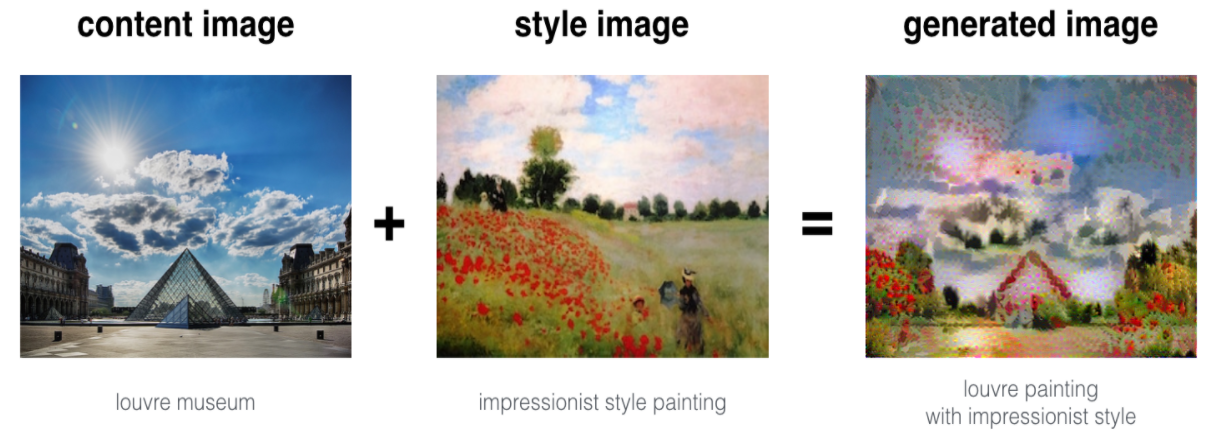
We didn't want you to wait too long to see an initial result, and so had set the hyperparameters accordingly. To get the best looking results, running the optimization algorithm longer (and perhaps with a smaller learning rate) might work better. After completing and submitting this assignment, we encourage you to come back and play more with this notebook, and see if you can generate even better looking images.
Here are few other examples:
-
The beautiful ruins of the ancient city of Persepolis (Iran) with the style of Van Gogh (The Starry Night)
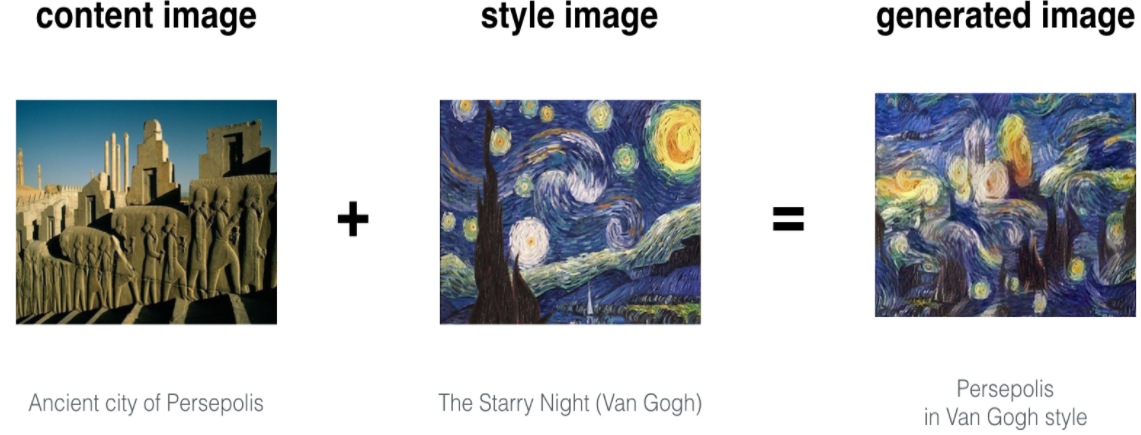
- The tomb of Cyrus the great in Pasargadae with the style of a Ceramic Kashi from Ispahan.
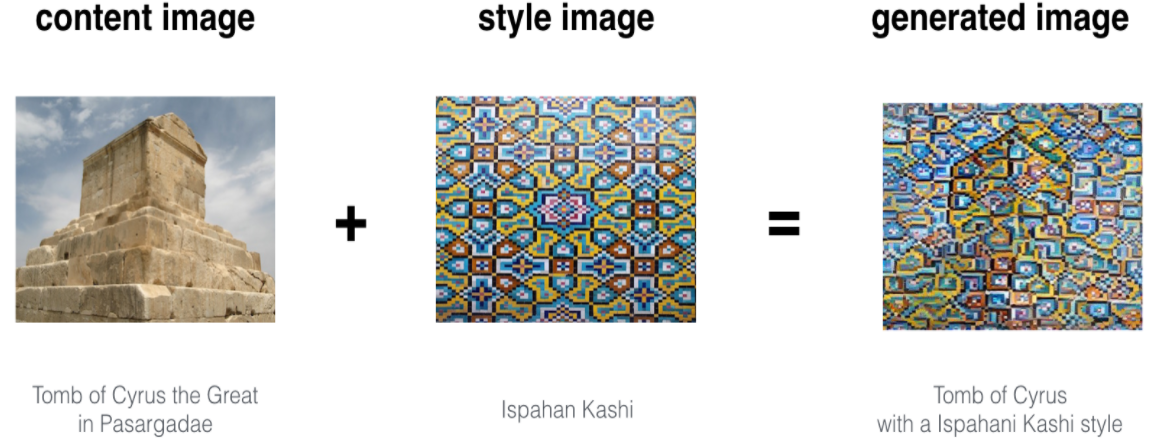
- A scientific study of a turbulent fluid with the style of a abstract blue fluid painting.
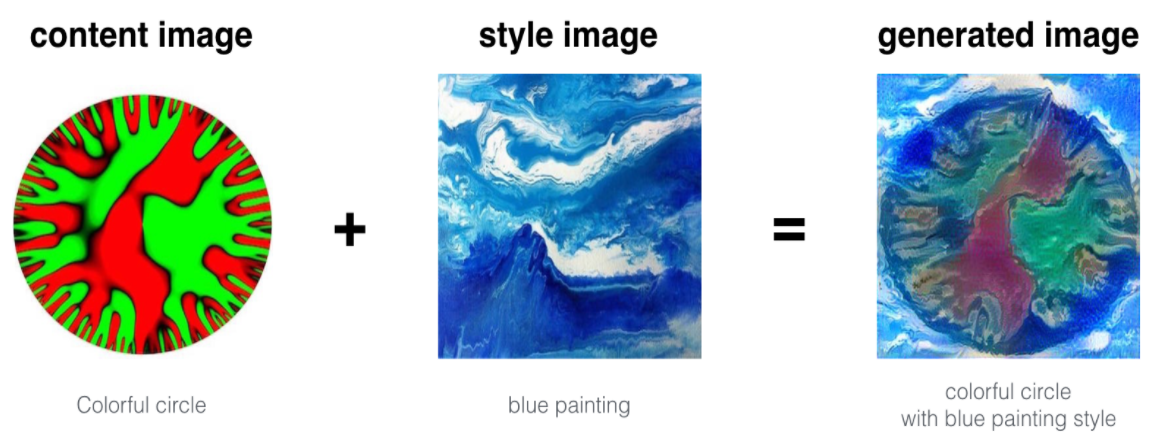
5 - Test with your own image (Optional/Ungraded)
Finally, you can also rerun the algorithm on your own images!
To do so, go back to part 4 and change the content image and style image with your own pictures. In detail, here's what you should do:
- Click on "File -> Open" in the upper tab of the notebook
- Go to "/images" and upload your images (requirement: (WIDTH = 400, HEIGHT = 300,像素400*300)), rename them "my_content.png" and "my_style.png" for example.
- Change the code in part (3.4) from :
to:content_image = scipy.misc.imread("images/louvre.jpg") style_image = scipy.misc.imread("images/claude-monet.jpg")content_image = scipy.misc.imread("images/my_content.jpg") style_image = scipy.misc.imread("images/my_style.jpg") - Rerun the cells (you may need to restart the Kernel in the upper tab of the notebook).
You can also tune your hyperparameters:
- Which layers are responsible for representing the style? STYLE_LAYERS
- How many iterations do you want to run the algorithm? num_iterations
- What is the relative weighting between content and style? alpha/beta
6 - Conclusion
Great job on completing this assignment! You are now able to use Neural Style Transfer to generate artistic images. This is also your first time building a model in which the optimization algorithm updates the pixel values rather than the neural network's parameters. Deep learning has many different types of models and this is only one of them!
What you should remember:
- Neural Style Transfer is an algorithm that given a content image C and a style image S can generate an artistic image
- It uses representations (hidden layer activations) based on a pretrained ConvNet.
- The content cost function is computed using one hidden layer's activations.
- The style cost function for one layer is computed using the Gram matrix of that layer's activations. The overall style cost function is obtained using several hidden layers.
- Optimizing the total cost function results in synthesizing new images.
This was the final programming exercise of this course. Congratulations--you've finished all the programming exercises of this course on Convolutional Networks! We hope to also see you in Course 5, on Sequence models!
References:
The Neural Style Transfer algorithm was due to Gatys et al. (2015). Harish Narayanan and Github user "log0" also have highly readable write-ups from which we drew inspiration. The pre-trained network used in this implementation is a VGG network, which is due to Simonyan and Zisserman (2015). Pre-trained weights were from the work of the MathConvNet team.
- Leon A. Gatys, Alexander S. Ecker, Matthias Bethge, (2015). A Neural Algorithm of Artistic Style (https://arxiv.org/abs/1508.06576)
- Harish Narayanan, Convolutional neural networks for artistic style transfer. https://harishnarayanan.org/writing/artistic-style-transfer/
- Log0, TensorFlow Implementation of "A Neural Algorithm of Artistic Style". http://www.chioka.in/tensorflow-implementation-neural-algorithm-of-artistic-style
- Karen Simonyan and Andrew Zisserman (2015). Very deep convolutional networks for large-scale image recognition (https://arxiv.org/pdf/1409.1556.pdf)
- MatConvNet. http://www.vlfeat.org/matconvnet/pretrained/